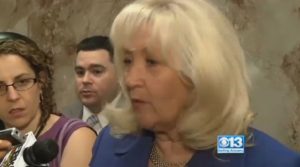On Friday, Governor Brown released his final “May Revise” budget proposal.
For those who aren’t fluent in government-ese, the May Revise is the Governor’s revised budget proposal, taking into account updated tax receipts, economic trends, and budget needs. It’s from this proposal that the Brown Administration will negotiate a final budget with Democratic legislative leaders.
May Revise day at the State Capitol is another day of great theater at the Capitol. The Governor announces the plan in his press conference room, with legislative leaders and advocates waiting outside, ready to give their reactions to the proposal as soon as reporters leave the room.

Those responding are asked to comment on the plan often without knowing what’s in it since they aren’t invited into the press conference and are standing in the hallway.
To give you a visual, to the left is a picture of me with my former boss, then-Assembly Republican Leader Connie Conway, doing what I usually did on May Revise days – lurking just off to the side of the camera listening to what she and other lawmakers were telling reporters.
Brown’s revised 2018-19 budget plan is right out of central casting for a Jerry Brown 2.0 budget plan.
Even though the State Controller estimates that tax revenue has grown by $3.8 billion over Brown’s January estimates, there was lots of talk about economic uncertainty and spending responsibly. In the press release announcing his plan, Brown stated that, “this is a time to save for our future, not to make pricey promises we can’t keep.” The introduction to his budget plan notes that by the end of the 2018-19 fiscal year, “the U.S. will have matched the longest recovery in modern history.”
The Governor’s plan sets the state on course to save the maximum amount allowed – $13.8 billion – in the Rainy Day Fund (for which then-Republican Leader Conway was a leading force in passing back in 2014). He proposes spending some of this year’s unanticipated tax revenue for one-time purposes. He also proposes continuing to pay back some of the budgetary borrowing the state employed in the last recession to paper over tough budgets without painful cuts.
Unfortunately, in some key areas, Gov. Brown’s budget approach has been more talk than action. Despite his talk of rejecting big spending by the Legislature, Brown proposes to increase state General Fund spending by $10 billion year over year. Total state spending – including General Fund, Special Fund, and Bond Fund spending – would be just shy of $200 billion.
Gov. Brown is certainly to be applauded for his actions on public employee pensions, including his amicus brief in the Cal Fire case challenging the California rule (PRI also filed an amicus brief in the case). However, the May Revise notes that the state faces $287 billion in unfunded state employee pension obligations – a $15 billion increase since January – but takes few steps to pay down this debt. As noted in PRI’s 2016 study California’s Pension Crowd Out, massive pension spending crowds out available funds for priorities like K-12 and higher education and public hospitals.
The debate now shifts to the Legislature, where the liberal majority is sure to push on Brown to use the state’s tax windfall to fund their big government priorities. As the Sacramento Bee notes, legislative liberals are already pushing to increase spending for government homeless programs, healthcare for undocumented immigrants, welfare grants, and the scandal-plagued UC system.
While I don’t know what final form the budget will take, I can say with certainty that it will be enacted by June 15. That’s because the law was changed a few years back to dock lawmaker pay for late budgets. Let the real budget debate now begin!
Tim Anaya is communications director for the Pacific Research Institute.

